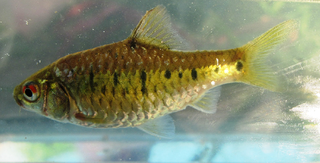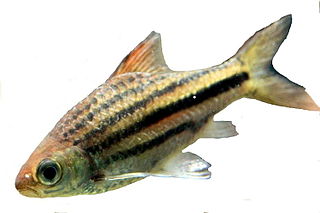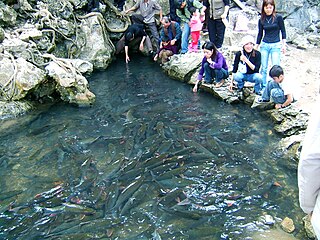
Cyprinidae is a family of freshwater fish commonly called the carp or minnow family. It includes the carps, the true minnows, and relatives like the barbs and barbels. Cyprinidae is the largest and most diverse fish family and the largest vertebrate animal family in general with about 3,000 species, of which only 1,270 remain extant, divided into about 370 genera. Cyprinids range from about 12 mm in size to the 3 m (9.8 ft) giant barb. By genus and species count, the family makes up more than two-thirds of the ostariophysian order Cypriniformes. The family name is derived from the Greek word kyprînos.

Barbodes semifasciolatus, the Chinese barb, is a species of cyprinid fish native to the Red River basin in southeast Asia where they occur in fresh waters at depths of 5 metres (16 ft) or less. The captive variant popularly known as the gold barb or Schuberti barb is an extremely popular aquarium fish.

The rosy barb is a subtropical freshwater cyprinid fish found in southern Asia from Afghanistan to Bangladesh.

The checker barb is a species of cyprinid fish endemic to creeks, rivers, and lakes in Sumatra, Indonesia. It has also been established in the wild in Colombia. The adult males have red fins with black tips. It will grow up to a length of 5 centimetres (2.0 in) TL. This species is the only known member of its genus.
The fiveband barb is a species of cyprinid freshwater fish from Southeast Asia. This species is restricted to blackwater streams and peat swamps in northwestern Borneo and possibly Peninsular Malaysia, but it has often been confused with the more widespread, closely related D. hexazona, which is similar except that it lacks the black spot at the rear base of the dorsal fin seen in D. pentazona.

The black ruby barb or purplehead barb is a tropical cyprinid fish endemic to Sri Lanka, where it occurs in forested streams from the Kelani basin to the Nilwala basin. They are found in streams on hills around 1000 ft in elevation. The brightly colored population introduced to Mahaweli at Ginigathena, Sri Lanka, is said to have diminished in number due to the aquarium export trade.

Puntius is a genus of small freshwater fish in the family Cyprinidae native to South Asia and Mainland Southeast Asia, as well as Taiwan.

The striped barb, is a species of cyprinid fish Cyprinidae native to the Malay Peninsula, Borneo, and Sumatra where it is found in the shallows of rivers, streams and ditches. This species can reach a length of 12 centimetres (4.7 in) TL. It is commercially important to local fisheries and can also be found in the aquarium trade.

Barbodes binotatus, commonly known as the spotted barb or common barb, is a tropical species of cyprinid fish endemic to Java, Indonesia.

Barbodes dunckeri, the bigspot barb or clown barb, is a species of cyprinid fish endemic to the Malay Peninsula where it inhabits clear streams and acidic swamps. This species can also be found in the aquarium trade. It was first discovered by Ernst Ahl in 1929.

Barbodes everetti, the Clown barb or Everett's barb is a species of cyprinid fish native to Borneo and Sumatra. It inhabits clear streams in forested foothills and can also be found in forest floor puddles as shallow as 15 centimetres (5.9 in) or less. Its diet consists of small crustaceans, worms, insects and plant material. This species can reach a length of 15 centimetres (5.9 in) TL. It can also be found in the aquarium trade.

Barbodes lateristriga, the spanner barb or T-barb, is a species of cyprinid fish native to the Malay Peninsula and the island of Borneo. It can reach a length of 18 centimetres (7.1 in) TL. This species can also be found in the aquarium trade.

Epalzeorhynchos is a small ray-finned fish genus of the family Cyprinidae. Its members are – like some other cyprinids – known as "freshwater sharks" or simply "sharks". They are, however, freshwater members of the Osteichthyes lineage which is distinct from the Chondrichthyes lineage of sharks. The description of these animals as "shark" is most likely a reference to the shark-like shape of these popular cyprinids.
Barbodes dorsimaculatus, the blackline barb, is a species of cyprinid fish endemic to Sumatra. This species can reach a length of 3.1 centimetres (1.2 in) TL. It can also be found in the aquarium trade.
Systomus endecanalis is a species of cyprinid fish endemic to the Kapuas River basin in western Borneo. This species can reach a standard length of 4.8 cm (1.9 in). Although placed in the genus Systomus by FishBase, it has been moved to Desmopuntius by Catalog of Fishes, following a taxonomic review by Maurice Kottelat in 2013.

Desmopuntius foerschi is a species of cyprinid endemic to southern Borneo. This species grows to a length of 5.3 centimetres (2.1 in) SL.
Desmopuntius gemellus is a species of cyprinid fish endemic to Sumatra. This species can reach a length of 6.5 centimetres (2.6 in) SL.

The lined barb is a species of cyprinid fish native to Malaysia and Indonesia where it can be found in swamps, standing waters with submerged grasses and blackwater rivers. This species can reach a length of 5.3 centimetres (2.1 in). It can also be found in the aquarium trade.
Desmopuntius trifasciatus is a species of cyprinid fish endemic to Indonesia where it can be found in dark, slowly flowing blackwater rivers. This species can reach a length of 9.6 centimetres (3.8 in) SL.

Spinibarbus denticulatus, the phoenix barb or Chinese phoenix barb, is an Asian species of cyprinid freshwater fish of the subfamily Spinibarbinae. This fish is found in China in the Yuanjiang and Pearl basins, freshwater systems of Hainan, and Yangzong and Fuxian Lakes, in Laos in the Mã basin, and in Vietnam in the Red, Gâm, Lô and Mã basins, and freshwater systems from Nghệ An to Quảng Trị province. It occurs in large to medium rivers, deep pools of streams, in lakes and reservoirs, and it has a quite broad temperature tolerance, between at least 9 and 30 °C (48–86 °F) depending on season. Overall the species is widespread, but some local populations have been reduced due to overfishing, habitat loss and pollution. It is an important food fish that sometimes is aquacultured, and also kept as a garden pond or aquarium fish. Large numbers of the species can be found in the Cẩm Lương stream in Cẩm Thủy, Vietnam, where it is considered sacred and the locals protect and feed it, and it is also a tourist attraction.















